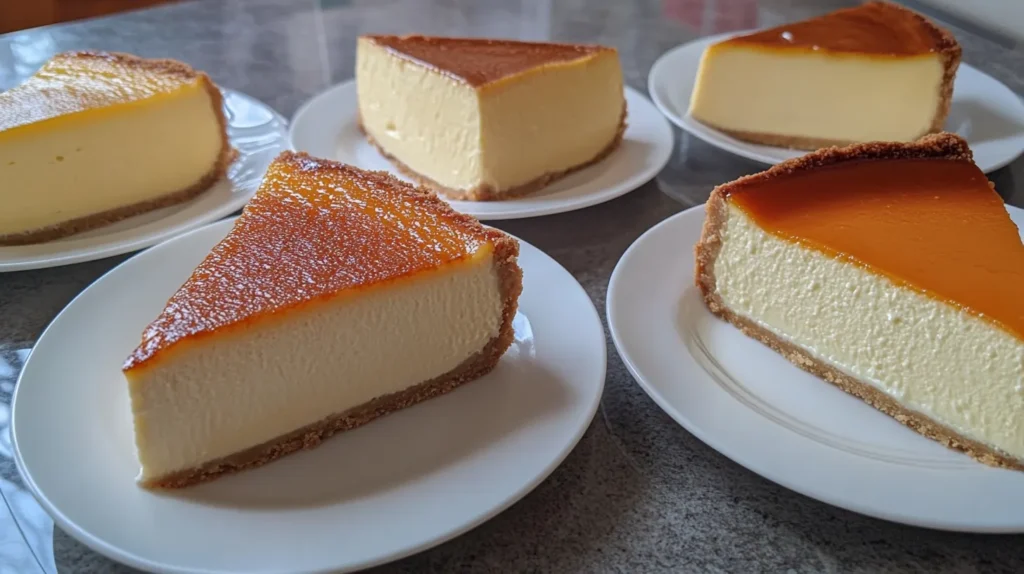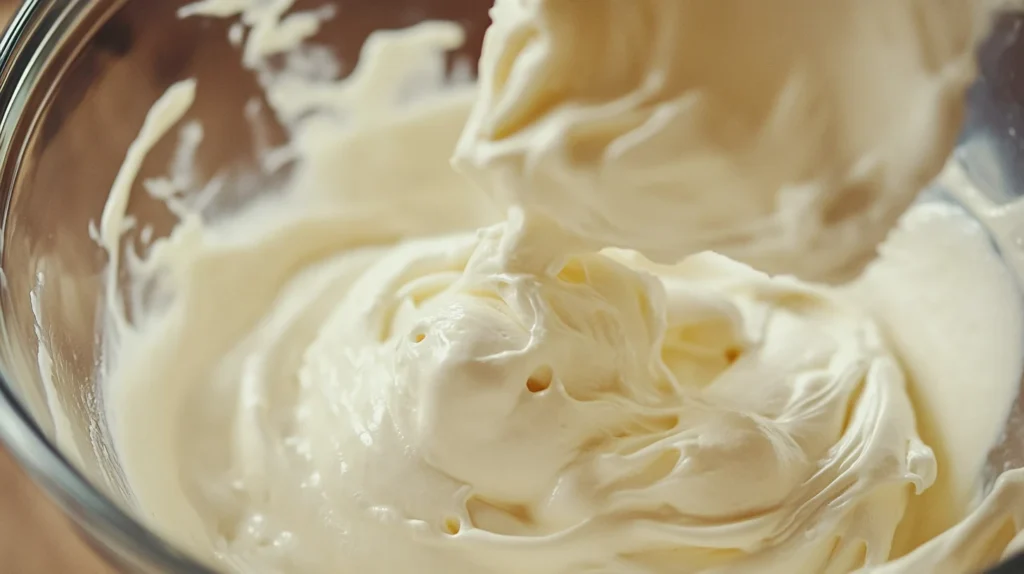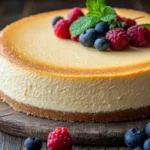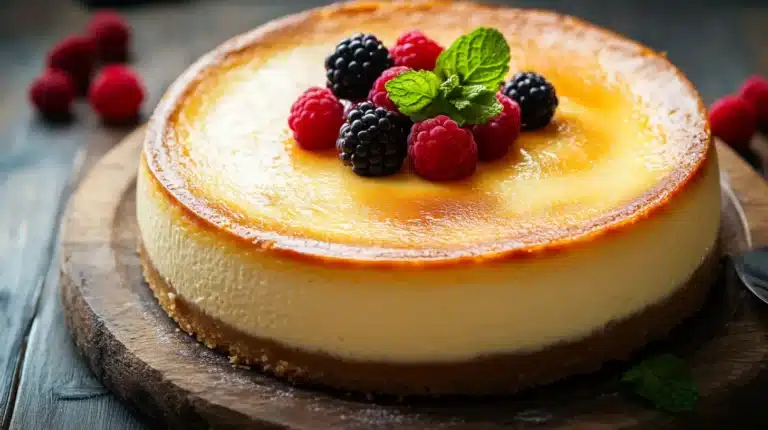French style cheesecake offers a unique and elegant take on traditional cheesecake, blending a light and airy texture with rich flavors that melt in your mouth. Unlike the dense, creamy consistency of New York or American-style cheesecakes, French cheesecake delivers a more delicate and refined experience. Whether enjoyed plain or topped with fresh fruits, this dessert has gained popularity worldwide for its balanced sweetness and subtle tang.
In this article, we will explore everything about French style cheesecake, from its origins and ingredients to the differences between other global cheesecake varieties. We will also provide a step-by-step recipe, expert tips, and pairing suggestions to ensure that your French cheesecake turns out perfectly.
Table of Contents
Introduction to French Style Cheesecake
What is French Style Cheesecake?
French style cheesecake, also known as “fromage blanc cheesecake” or “gâteau au fromage,” is a type of cheesecake that uses soft cheeses like fromage blanc, mascarpone, or cream cheese blended with eggs and sugar. This combination creates a smooth, velvety texture with a slightly tangy aftertaste. Unlike American cheesecakes that often use a graham cracker crust, French cheesecakes typically feature a thin pastry crust or are sometimes crustless, allowing the creamy filling to take center stage.
The lightness of French style cheesecake is achieved through the use of beaten egg whites or whipped cream, which are gently folded into the batter to add airiness. As a result, the dessert feels less heavy and is often preferred as a sophisticated end to a meal.
History and Origins of French Cheesecake
The origins of French style cheesecake can be traced back to ancient European baking traditions. While the concept of cheesecake dates as far back as Ancient Greece, the French version developed over centuries, incorporating native ingredients and local techniques. French pâtissiers refined the process by introducing fromage blanc, a fresh and creamy cheese, which became a staple in many regional variations.
By the 18th and 19th centuries, French style cheesecake gained prominence as a luxurious dessert served in aristocratic households. It was commonly flavored with vanilla, lemon zest, or even liqueurs, reflecting France’s culinary sophistication. Today, French style cheesecake remains a beloved delicacy in French bakeries and patisseries, cherished for its light texture and refined taste.
To explore more about the origins and variations of French style cheesecake, check out our detailed guide on French Cheesecake.
Ingredients and Key Differences from Traditional Cheesecakes
Common Ingredients in French Cheesecake
French style cheesecake uses a refined selection of ingredients that contribute to its light, airy texture and delicate flavor. Here’s a closer look at the essential components:
- Fromage Blanc or Cream Cheese: The primary ingredient in French cheesecake, fromage blanc is a soft, fresh cheese with a mild tang. When unavailable, cream cheese or mascarpone can be substituted, though fromage blanc provides a lighter consistency.
- Eggs: Eggs play a crucial role in binding the ingredients and giving the cheesecake structure. The whites are often whipped separately to incorporate air and ensure a smooth, fluffy texture.
- Sugar: Granulated sugar adds sweetness and balances the natural tanginess of the cheese. The amount of sugar used in French cheesecake is typically less than in American versions, emphasizing the natural flavors.
- Heavy Cream or Crème Fraîche: These ingredients add richness and contribute to the velvety texture, while also balancing the tang of the cheese.
- Flour or Cornstarch: A small amount of flour or cornstarch helps stabilize the filling and prevent cracks during baking.
- Vanilla or Lemon Zest: For added depth of flavor, vanilla extract or lemon zest is often incorporated into the batter. These ingredients enhance the natural sweetness and provide a fragrant aroma.
Differences Between French and Regular Cheesecake
French style cheesecake stands out from regular cheesecakes in several key aspects, making it a distinct and elegant dessert choice.
1. Texture and Consistency
- French cheesecake is significantly lighter and more delicate than American or New York-style cheesecake. The incorporation of whipped egg whites or cream results in an airy, almost mousse-like texture.
- Regular cheesecakes, particularly New York style, are dense and rich due to the heavy use of cream cheese and a thick layer of filling.
2. Crust Variation
- French style cheesecakes often use a thin pastry crust or are entirely crustless, allowing the silky filling to be the star of the dessert.
- Traditional American cheesecakes rely on a thick graham cracker or biscuit crust, providing a crumbly contrast to the creamy filling.
3. Baking Method
- French cheesecake is typically baked in a water bath (bain-marie) to ensure gentle heat distribution, preventing cracks and maintaining a smooth texture.
- New York style cheesecake is usually baked at a higher temperature, often resulting in a firmer consistency with a golden brown top.
4. Sweetness Level
- French style cheesecake leans toward a mildly sweet profile, allowing the natural tang of the cheese to shine through.
- Regular cheesecakes tend to be sweeter, often with added sugar in the crust and toppings.
5. Flavor Profile
- French cheesecake embraces subtle flavor enhancements such as vanilla, citrus, or almond, while American cheesecakes are often topped with fruit sauces, caramel, or chocolate for a more indulgent finish.
Learn how to perfect the texture of French cheesecake by comparing it with other variations in this comprehensive French Cheesecake guide.
Types of Cheesecakes Around the World
New York Cheesecake vs. French Style Cheesecake
New York cheesecake and French style cheesecake differ in texture, ingredients, and overall flavor profile.
Texture and Density
- New York cheesecake is known for its dense, rich, and creamy consistency due to the heavy use of cream cheese, eggs, and sour cream. It has a thick, velvety texture that feels indulgent.
- French style cheesecake, on the other hand, is light and airy with a smoother, more delicate texture. The inclusion of fromage blanc or whipped egg whites gives it a mousse-like quality, making it feel less heavy.

Crust and Baking Technique
- New York cheesecake is typically baked with a thick graham cracker crust that provides a crunchy contrast to the creamy filling. It is baked at a high temperature, often creating a slightly browned top.
- French style cheesecake usually features a thin pastry crust or no crust at all, allowing the silky filling to take center stage. It is baked at a lower temperature in a water bath, which prevents cracks and maintains a smooth surface.
Flavor Profile
- New York cheesecake tends to be sweeter and richer, with flavors enhanced by vanilla and sometimes lemon zest.
- French style cheesecake offers a more subtle sweetness with a slight tang from the use of fresh cheeses like fromage blanc or mascarpone.
Basque Cheesecake vs. Japanese Cheesecake
Basque and Japanese cheesecakes provide two more contrasting styles, each with their unique characteristics.
Basque Cheesecake
- Originating from the Basque region of Spain, Basque cheesecake is famous for its caramelized, burnt top and creamy center. It is intentionally baked at a high temperature, creating a rustic, almost soufflé-like texture with a slightly molten core.
- Unlike French cheesecake, Basque cheesecake does not require a water bath, and its burnt top adds a deep, rich flavor that contrasts with the smooth filling.
Japanese Cheesecake
- Japanese cheesecake, often called “soufflé cheesecake,” is incredibly light and fluffy due to the incorporation of whipped egg whites. It blends cream cheese with a meringue base, resulting in a cloud-like texture that melts in the mouth.
- While French cheesecake shares a similar lightness, Japanese cheesecake is even more airy, almost resembling a sponge cake in texture.
American vs. European Cheesecake
American and European cheesecakes differ significantly in their ingredients and preparation methods.
Ingredient Variations
- American cheesecakes often use cream cheese as the primary ingredient, along with heavy cream and sugar, creating a dense and creamy filling.
- European versions, including French style cheesecake, frequently incorporate soft cheeses like fromage blanc, ricotta, or quark, giving them a lighter, tangier profile.
Baking Techniques
- American cheesecakes are usually baked at higher temperatures, often with a graham cracker crust and a firm texture.
- European cheesecakes are more likely to be baked at a lower temperature in a water bath, preserving their light and silky consistency.
If you’re looking for a fruit-infused twist, consider trying a Lemon Blueberry Cheesecake that combines tangy citrus with a burst of berries.
French Style Cheesecake vs. Sicilian Cheesecake
Key Ingredients and Texture Differences
French style cheesecake and Sicilian cheesecake, though both European in origin, differ significantly in ingredients and texture.
Cheese Base
- French style cheesecake primarily uses fromage blanc, a soft, tangy cheese that gives the dessert a smooth and light texture. In some variations, mascarpone or cream cheese is used, but the emphasis is on achieving a delicate, airy consistency.
- Sicilian cheesecake, known as Cassata al Forno, uses ricotta cheese as its base. Ricotta, made from sheep’s milk or cow’s milk, has a slightly grainy texture and a mild, slightly sweet flavor that contributes to the distinct texture of Sicilian cheesecake.
Sweeteners and Flavorings
- French cheesecake typically uses granulated sugar and is often flavored with vanilla or lemon zest for a refined and subtle sweetness.
- Sicilian cheesecake incorporates honey, candied fruits, and citrus zest, giving it a richer, more complex flavor profile. It may also include ingredients like cinnamon or chocolate, adding depth to the dessert.
Crust and Layers
- French style cheesecake often features a thin pastry crust or no crust at all, focusing on the smooth, velvety filling.
- Sicilian cheesecake is typically baked with a shortcrust pastry base, which adds a crunchy, buttery contrast to the creamy ricotta filling. The pastry may also be layered or enclosed around the filling, resembling a pie.
Baking Techniques Compared
The baking methods for French and Sicilian cheesecakes differ, affecting their final texture and consistency.
French Style Cheesecake Baking
- French cheesecake is traditionally baked in a water bath (bain-marie) to maintain gentle heat and prevent cracking. This technique ensures that the filling remains soft and silky.
- The baking temperature is typically lower, which helps achieve a smooth, even texture without browning the top.
Sicilian Cheesecake Baking
- Sicilian cheesecake is baked at a higher temperature, often without a water bath. The shortcrust pastry base holds the ricotta filling, and the higher heat allows the crust to become golden and crispy.
- Due to the denser filling, Sicilian cheesecake maintains a more compact and slightly crumbly texture compared to the light, mousse-like consistency of French cheesecake.
Flavor and Serving Style
French Style Cheesecake
- French cheesecake tends to be mildly sweet, allowing the natural flavors of the cheese to shine. It is often served plain or with a dusting of powdered sugar, and occasionally accompanied by fresh fruits or a light fruit compote.
Sicilian Cheesecake
- Sicilian cheesecake is richer and more aromatic, with bold flavors from candied fruits, honey, and spices. It is often enjoyed as a festive dessert, particularly during holidays and celebrations, and may be garnished with powdered sugar or additional candied fruit on top.
For those who enjoy lighter desserts, this Strawberry Vanilla Cake recipe offers a perfect balance of sweetness and flavor.
Step-by-Step Recipe for French Style Cheesecake
Ingredients Needed
To create an authentic French style cheesecake, you will need the following ingredients:
For the Crust:
- 1 cup all-purpose flour
- 1/4 cup unsalted butter, chilled and cubed
- 2 tablespoons granulated sugar
- 1 egg yolk
- 1-2 tablespoons cold water (optional, for consistency)
For the Filling:
- 500g (about 2 cups) fromage blanc or cream cheese
- 3 large eggs, separated
- 1/2 cup granulated sugar
- 1/2 cup heavy cream or crème fraîche
- 1 tablespoon all-purpose flour or cornstarch
- 1 teaspoon vanilla extract or lemon zest for flavor
Preparation and Baking Instructions
Step 1: Prepare the Crust
- Preheat the oven to 325°F (160°C). Grease a 9-inch springform pan and line the bottom with parchment paper.
- In a mixing bowl, combine the flour, sugar, and chilled butter. Use your fingertips or a pastry cutter to mix until the mixture resembles coarse crumbs.
- Add the egg yolk and mix until the dough begins to come together. If the dough feels too dry, add a tablespoon of cold water.
- Press the dough evenly into the bottom of the prepared pan. Prick with a fork to prevent air bubbles.
- Bake the crust for 10-12 minutes or until lightly golden. Remove from the oven and allow to cool while preparing the filling.
Step 2: Prepare the Filling
- In a large mixing bowl, beat the fromage blanc (or cream cheese) with sugar until smooth and creamy.
- Add the heavy cream, vanilla extract (or lemon zest), and flour or cornstarch. Mix until fully combined.
- Separate the egg yolks from the whites. Add the yolks one at a time, mixing well after each addition.
- In a separate bowl, beat the egg whites until stiff peaks form. Gently fold the beaten egg whites into the cheese mixture using a spatula. This step adds air to the batter, giving the cheesecake its signature light texture.

Step 3: Assemble and Bake
- Pour the filling over the prepared crust, smoothing the top with a spatula.
- Place the springform pan in a larger roasting pan. Pour hot water into the roasting pan until it reaches halfway up the sides of the springform pan. This water bath (bain-marie) helps maintain a gentle, even heat.
- Bake for 45-50 minutes or until the edges are set but the center still has a slight wobble.
- Turn off the oven and leave the cheesecake inside with the door slightly ajar for about 1 hour. This helps prevent cracking.
Step 4: Cool and Chill
- Remove the cheesecake from the water bath and allow it to cool completely at room temperature.
- Once cooled, refrigerate for at least 4 hours or overnight to allow the flavors to develop and the texture to set.
Step 5: Serve and Enjoy
- Carefully remove the cheesecake from the springform pan.
- Serve plain or garnish with fresh fruits, a light fruit glaze, or powdered sugar for an elegant touch.
If you’re a fan of chocolate, don’t miss out on our indulgent Chocolate Chip Cheesecake recipe, which adds a delicious twist to traditional cheesecakes.
Tips for Perfecting Your French Style Cheesecake
Avoiding Common Mistakes
1. Do Not Overmix the Batter
Overmixing the batter can introduce too much air, causing the cheesecake to rise too quickly and then collapse during baking. Mix the ingredients gently and stop once the batter is smooth and well combined.
2. Use Room Temperature Ingredients
Ensure that all ingredients, especially the fromage blanc (or cream cheese), eggs, and heavy cream, are at room temperature before mixing. This prevents lumps and helps achieve a smoother filling.
3. Be Gentle When Folding Egg Whites
When incorporating whipped egg whites into the batter, use a gentle folding technique to maintain the airiness. Avoid vigorous mixing, as this can deflate the egg whites and result in a denser texture.
4. Prevent Cracks by Using a Water Bath
Baking the cheesecake in a water bath (bain-marie) ensures that heat is evenly distributed, preventing the surface from drying out and cracking. Wrap the bottom of the springform pan in aluminum foil to prevent water from seeping into the crust.
5. Avoid Overbaking
French style cheesecake should have a slight wobble in the center when removed from the oven. Overbaking can result in a dry, cracked surface. The cheesecake will continue to set as it cools, so err on the side of underbaking rather than leaving it too long.
6. Allow Slow Cooling to Prevent Cracks
After baking, turn off the oven and let the cheesecake cool gradually with the oven door slightly ajar. This slow cooling process helps prevent sudden temperature changes that could cause the cheesecake to crack.
Best Techniques for a Creamy Texture
1. Use a High-Quality Cheese
For the best results, opt for high-quality fromage blanc or a combination of cream cheese and mascarpone. The quality of the cheese directly impacts the flavor and texture of the cheesecake.
2. Add a Touch of Cornstarch or Flour
Incorporating a tablespoon of cornstarch or flour helps stabilize the filling and prevents it from curdling. This also contributes to a creamier, smoother consistency.
3. Whip the Cream Separately for Extra Airiness
If you prefer an even lighter texture, consider whipping the heavy cream separately and folding it into the batter along with the egg whites. This extra step adds volume and enhances the mousse-like quality of the cheesecake.
4. Chill Overnight for Maximum Flavor
For the best flavor and texture, allow the cheesecake to chill in the refrigerator for at least 4 hours, preferably overnight. This resting period allows the flavors to meld and the texture to set perfectly.
Pro Tip: Test Doneness with a Gentle Jiggle
To determine if your cheesecake is ready, gently jiggle the pan. The edges should be set, but the center should have a slight wobble. If the center looks too liquid, continue baking for a few more minutes, but be cautious not to overbake.
Curious about unique cheesecake variations? Discover what makes Churro Cheesecake a delightful fusion of flavors.
Pairing and Serving Suggestions
Best Wine Pairings for French Cheesecake
Pairing French style cheesecake with the right wine enhances its delicate flavors and elevates the overall dessert experience. Since French cheesecake is lighter and less sweet than American varieties, it pairs well with wines that complement its tangy and creamy profile.
1. Champagne or Sparkling Wine
- Champagne, with its crisp acidity and fine bubbles, balances the richness of the cheesecake and cleanses the palate after each bite.
- A brut or extra brut Champagne is ideal, as it is dry enough to contrast with the subtle sweetness of the dessert.
2. Sauternes or Late Harvest Wines
- Sauternes, a sweet French wine from the Bordeaux region, has honeyed notes of apricot, peach, and citrus that complement the creamy texture of the cheesecake.
- Late harvest Rieslings or Gewürztraminers also pair beautifully, offering a balance of sweetness and acidity that harmonizes with the tangy notes of the cheese.
3. Moscato d’Asti
- This lightly sparkling, sweet Italian wine has floral and fruity aromas that enhance the vanilla or lemon zest flavors in the cheesecake. Its low alcohol content makes it a refreshing choice for pairing.
4. Vin Santo or Sweet Sherry
- Vin Santo, an Italian dessert wine with nutty and caramel flavors, pairs well with cheesecakes that have a hint of citrus or almond.
- Sweet sherry, such as Pedro Ximénez, provides a rich contrast to the light, creamy texture of the cheesecake.
Serving Suggestions for Special Occasions
1. Fresh Fruit Garnish
- Top your French style cheesecake with fresh berries, sliced peaches, or figs for a burst of natural sweetness. The slight tartness of the fruit balances the richness of the cheesecake.
- Dust with powdered sugar or a drizzle of honey for an elegant presentation.
2. Light Fruit Sauce or Coulis
- A berry coulis or a light citrus sauce adds a refreshing contrast to the creamy texture. Strawberry, raspberry, or passion fruit sauces enhance the flavors without overpowering the cheesecake.
- Serve the sauce on the side, allowing guests to add as much as they desire.
3. Whipped Cream and Mint
- For a classic touch, serve the cheesecake with a dollop of lightly sweetened whipped cream and a sprig of fresh mint.
- The creaminess complements the texture, while the mint adds a hint of freshness.
4. Almond or Caramel Drizzle
- Drizzle a thin layer of caramel or almond sauce over the cheesecake for a rich, nutty flavor that contrasts with the light filling.
- Toasted almond slices can also be sprinkled on top for added crunch and visual appeal.
5. Crushed Pistachios or Hazelnuts
- For a sophisticated twist, sprinkle finely crushed pistachios or hazelnuts on top of the cheesecake. This adds a delicate crunch that enhances the smooth texture.
Presentation Tips
1. Slice with a Warm Knife
- To achieve clean and precise slices, run a sharp knife under hot water, dry it, and then cut through the cheesecake. Repeat this process between slices for a professional presentation.
2. Serve on Elegant Plates
- Present your cheesecake on elegant dessert plates with a dusting of powdered sugar or edible flowers to enhance the visual appeal.
Looking for a show-stopping dessert? This Strawberry Crunch Cake recipe is perfect for special celebrations.

For a more indulgent variation, try our Cinnamon Roll Cheesecake that combines creamy richness with a hint of warm cinnamon.
FAQs
1. What is the difference between French style cheesecake and regular cheesecake?
French style cheesecake is lighter and more delicate compared to regular cheesecakes like New York or American-style. It uses fromage blanc or a mix of cream cheese and mascarpone, resulting in a smooth and airy texture. Regular cheesecakes, especially New York style, are denser and richer due to the use of cream cheese and sour cream. Additionally, French style cheesecakes often feature a thin pastry crust or no crust, while regular cheesecakes typically use a graham cracker base.
2. What are the three types of cheesecake?
The three main types of cheesecake are:
New York Style Cheesecake: Known for its dense, creamy texture and thick graham cracker crust. It’s rich and often served plain or with fruit toppings.
French Style Cheesecake: A lighter and more delicate version, often crustless or with a thin pastry base, made with fromage blanc or mascarpone.
Basque Cheesecake: Originating from Spain, Basque cheesecake has a caramelized, burnt top with a creamy, slightly molten center.
3. What is the difference between American and European cheesecake?
American cheesecakes, particularly New York style, use cream cheese as the primary ingredient, resulting in a dense, creamy texture. They often include a thick graham cracker crust and are sweeter compared to their European counterparts. European cheesecakes, including French style, often use softer cheeses like ricotta, mascarpone, or fromage blanc. These versions are lighter, less sweet, and may have a more tangy flavor. European cheesecakes are also more likely to be baked at a lower temperature, often in a water bath, to achieve a smooth consistency.
4. What is the difference between NY cheesecake and Basque?
New York cheesecake is dense, rich, and smooth, often with a graham cracker crust and a firm texture. It is baked slowly at a lower temperature to maintain its consistency. Basque cheesecake, on the other hand, has a rustic, burnt top with a creamy, slightly molten interior. It is baked at a higher temperature, resulting in a caramelized exterior and a softer center. Basque cheesecake does not typically have a crust, allowing the filling to shine.
5. What is Japanese style cheesecake?
Japanese style cheesecake, also known as “soufflé cheesecake,” is incredibly light and fluffy. It incorporates a meringue base, where whipped egg whites are folded into the batter to create an airy, sponge-like texture. Japanese cheesecake is often less sweet than American versions and melts in the mouth, making it a unique and delicate alternative.
6. What is the difference between Sicilian cheesecake and New York cheesecake?
Sicilian cheesecake, also known as Cassata al Forno, uses ricotta cheese, giving it a slightly grainy texture and a mild, sweet flavor. It often features candied fruits, honey, and citrus zest for added complexity. The crust is typically a short crust pastry that adds a crispy contrast to the filling. In contrast, New York cheesecake uses cream cheese, resulting in a dense, smooth texture. It is baked with a graham cracker crust and has a rich, creamy flavor that is often paired with fruit or chocolate toppings.
For a refreshing summer treat, consider making a Strawberry Banana Cheesecake Salad that blends fruity flavors with a creamy texture.
Conclusion and Final Thoughts
Recap of Key Differences and Tips
French style cheesecake offers a refined, lighter alternative to traditional American and New York-style cheesecakes. Made with fromage blanc or a combination of cream cheese and mascarpone, French cheesecake has a smooth, airy texture that melts in your mouth. Its delicate flavor profile, often enhanced with vanilla or lemon zest, pairs beautifully with fresh fruits or light sauces.
The key differences between French style cheesecake and other varieties include:
- Texture: French cheesecake is lighter and less dense, often achieved by folding whipped egg whites into the batter.
- Crust: It may feature a thin pastry crust or be served crustless, allowing the filling to shine.
- Baking Method: French cheesecake is typically baked in a water bath (bain-marie), ensuring even heat distribution and preventing cracks.
To perfect your French cheesecake, remember to use room temperature ingredients, avoid overmixing the batter, and allow slow cooling after baking to prevent cracks. A gentle hand when folding egg whites and careful monitoring of the baking time will ensure a silky, mousse-like texture.
Why French Style Cheesecake is Worth Trying
French style cheesecake is an elegant dessert that brings a touch of sophistication to any occasion. Its lightness makes it an ideal choice for those who prefer a less heavy dessert after a meal. Paired with fresh fruit, a berry coulis, or a glass of sparkling wine, French cheesecake offers a harmonious balance of flavors that delights the palate.
Whether you are looking to impress guests at a dinner party or simply indulge in a homemade treat, French style cheesecake is a versatile and rewarding dessert. Its delicate texture, refined flavors, and simple preparation make it a must-try for any cheesecake lover.
Craving a light dessert option? Check out our Strawberry Vanilla Cake recipe for a delightful twist.
Ready to experience the elegance of French style cheesecake? Follow the detailed recipe provided and enjoy a slice of this exquisite dessert. Bon appétit!
Print
French Style Cheesecake: A Delectable Twist on Classic Desserts
- Total Time: 1 hour 10 minutes (plus 4 hours of chilling time)
- Yield: 1 cheesecake (9-inch) 1x
Description
French style cheesecake offers a delicate and sophisticated take on traditional cheesecake, with a light, airy texture that melts in your mouth. Made with fromage blanc or cream cheese, whipped egg whites, and subtle flavors of vanilla or lemon zest, this dessert is perfect for those who prefer a less sweet and tangy cheesecake. It’s often served plain or with fresh fruit, making it a versatile and elegant choice for any occasion.
Ingredients
For the Crust:
1 cup all-purpose flour
1/4 cup unsalted butter, chilled and cubed
2 tablespoons granulated sugar
1 egg yolk
1–2 tablespoons cold water (optional, for consistency)
For the Filling:
500g (about 2 cups) fromage blanc or cream cheese
3 large eggs, separated
1/2 cup granulated sugar
1/2 cup heavy cream or crème fraîche
1 tablespoon all-purpose flour or cornstarch
1 teaspoon vanilla extract or lemon zest (for flavor)
Instructions
Step 1: Prepare the Crust
Preheat the oven to 325°F (160°C). Grease a 9-inch springform pan and line the bottom with parchment paper.
In a mixing bowl, combine the flour, sugar, and chilled butter. Use your fingertips or a pastry cutter to mix until the mixture resembles coarse crumbs.
Add the egg yolk and mix until the dough begins to come together. Add 1-2 tablespoons of cold water if the dough feels too dry.
Press the dough evenly into the bottom of the prepared pan. Prick with a fork to prevent air bubbles.
Bake for 10-12 minutes or until lightly golden. Remove from the oven and allow to cool while preparing the filling.
Step 2: Prepare the Filling
In a large mixing bowl, beat the fromage blanc (or cream cheese) with sugar until smooth and creamy.
Add the heavy cream, vanilla extract (or lemon zest), and flour or cornstarch. Mix until fully combined.
Separate the egg yolks from the whites. Add the yolks one at a time, mixing well after each addition.
In a separate bowl, beat the egg whites until stiff peaks form.
Gently fold the beaten egg whites into the cheese mixture using a spatula to maintain the airy texture.
Step 3: Assemble and Bake
Pour the filling over the prepared crust, smoothing the top with a spatula.
Place the springform pan in a larger roasting pan. Pour hot water into the roasting pan until it reaches halfway up the sides of the springform pan. This water bath (bain-marie) helps prevent cracks.
Bake for 45-50 minutes or until the edges are set but the center has a slight wobble.
Turn off the oven and leave the cheesecake inside with the door slightly ajar for 1 hour.
Step 4: Cool and Chill
Remove the cheesecake from the water bath and allow it to cool completely at room temperature.
Once cooled, refrigerate for at least 4 hours or overnight to allow the flavors to develop and the texture to set.
Step 5: Serve and Enjoy
Carefully remove the cheesecake from the springform pan.
Serve plain or garnish with fresh fruits, a light fruit glaze, or a dusting of powdered sugar.
Notes
Tip: For best results, use room temperature ingredients to achieve a smooth, lump-free filling.
Serving Suggestion: Pair with a glass of Champagne or a sweet dessert wine like Sauternes to enhance the delicate flavors.
Variation: Add a drizzle of fruit coulis or a sprinkle of crushed pistachios for an extra burst of flavor.
- Prep Time: 20 minutes
- Cook Time: 50 minutes
- Category: Dessert
- Cuisine: French
Nutrition
- Serving Size: 8 servings
- Calories: 320 per serving
- Fat: 20g
- Carbohydrates: 28g
- Protein: 7g
Keywords: French Style Cheesecake

